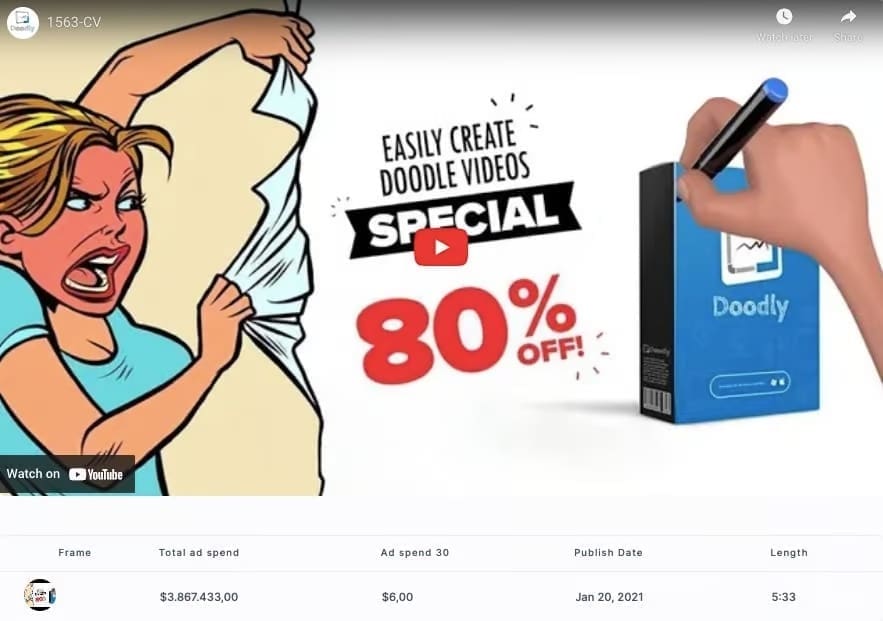
Hello, fellow content creators!
Want to increase your YouTube video views and grow your channel? Then stick around because I’m about to break down how the YouTube algorithm works in 2024 and give you practical tips to help your videos get noticed. 🦸
We’ll cover:
- 📜 A brief history of the YouTube algorithm
- ⚙️ How the YouTube algorithm works in 2024
- 📝 Optimizing your video titles and descriptions
- 🎨 Creating eye-catching thumbnails
- 🎬 Producing engaging content
- 🎥 Understanding YouTube Shorts
- 📊 Using YouTube analytics
Want to brainstorm with our team on new ways to scale your business with YouTube Ads (and other performance video platforms)?
Join us for a free YouTube ad brainstorming session👇
By the end, you’ll have a clear understanding of how to make the algorithm work in your favor. ¡Vamos!
📜 A brief history of the YouTube algorithm
Understanding the evolution of the YouTube algorithm helps us grasp how it influences content discovery today. Here’s a quick overview to get you up to speed:
2005-2011: Clicks and Views
Initially, YouTube’s algorithm prioritized clicks and views. This led to the rise of clickbait—misleading titles and thumbnails designed to attract clicks, often disappointing viewers and reducing the quality of the user experience (Buffer) (WordStream).
2012: Watch Time
In 2012, YouTube shifted its focus to watching time, favoring videos that kept viewers engaged longer. This change reduced clickbait and encouraged creators to produce content that viewers would watch all the way through (Buffer) (SocialPilot).
2015-2016: Viewer Satisfaction
By 2015, YouTube started measuring viewer satisfaction more directly through surveys and engagement metrics like likes and shares. The goal was to ensure that recommended videos were not only watched but also enjoyed (Social Media Dashboard) (Sprout Social).
2016-Present: Content Moderation and Brand Safety
From 2016 onwards, YouTube implemented stricter guidelines to combat harmful or misleading content. Changes in 2019 aimed to reduce the spread of borderline content by 70%, balancing the need for diverse opinions with the responsibility to prevent misinformation (WordStream) (SocialPilot).
This evolution shows how YouTube has continuously refined its algorithm to enhance user experience and address broader concerns, helping you create better ads that align with current algorithmic priorities.
⚙️ How the YouTube algorithm works in 2024

Understanding the YouTube algorithm is essential for creating content that gets noticed. Here’s an in-depth look at how it works in 2024, including its core objectives, key factors, and how it delivers personalized recommendations.
Core objectives
- Maximize user engagement: The algorithm promotes videos that keep viewers watching longer, encouraging them to spend more time on the platform.
- Increase watch time: It favors videos that retain viewers and prompts them to watch additional videos.
- Boost revenue: By increasing engagement and watch time, YouTube can show more ads, thus generating higher ad revenue (Social Media Dashboard) (Buffer) (SocialPilot).
Key factors considered by the algorithm
1. Video metadata
- Titles: Titles should be clear, and engaging, and include relevant keywords that align with what users are searching for. For example, a title like “10 Tips for a Better Night’s Sleep” directly addresses common search queries about sleep improvement.
- Descriptions: A detailed description helps the algorithm understand the content. It should summarize the video, include keywords, and provide additional context. For instance, a video about cooking should mention the recipe, ingredients, and cooking steps in the description.
- Tags: Tags help categorize the video, making it easier for the algorithm to understand its topic. Tags should be specific to the video’s content to ensure accurate classification (WordStream) (Sprout Social).
2. Viewer interaction
- Likes and dislikes: These metrics are straightforward indicators of viewer satisfaction. A high number of likes suggests the content is well-received, while dislikes can indicate the opposite.
- Comments: Videos with more comments are generally more engaging, as they encourage viewers to participate in a discussion.
- Shares: When viewers share a video, it signals to YouTube that the content is valuable and worth recommending to others (SocialPilot) (Buffer).
3. Content relevance
- Search terms: The algorithm matches videos to the terms users search for. If someone searches for “home workout routines,” videos with titles, descriptions, and tags related to home workouts will be prioritized.
- Watch history: YouTube tailors recommendations based on what a user has previously watched. If a user frequently watches cooking videos, the algorithm will suggest more cooking content.
- Topic relevance: The algorithm also considers trending topics. Videos about current events or popular subjects are more likely to be recommended (WordStream) (Sprout Social).
4. Video performance
- Click-through rate (CTR): This is the ratio of viewers who click on your video after seeing its thumbnail. A higher CTR indicates that the thumbnail and title are effective in attracting viewers.
- Average view duration: This metric shows how long viewers watch your video on average. Longer view durations are a positive signal to the algorithm.
- Audience retention: This measures how well your video keeps viewers engaged throughout. High retention rates indicate that viewers are watching most or all of your video (Buffer) (SocialPilot).
Personalized recommendations
The YouTube algorithm delivers personalized recommendations through various methods:
- Home page: When users open YouTube, the home page displays videos tailored to their interests based on watch history and engagement patterns. For example, if a user frequently watches travel vlogs, they will see more travel-related content on their home page.
- Suggested videos: These are the videos recommended alongside the one currently being watched. They are selected based on the current video’s topic and the viewer’s past behavior. If you’re watching a video on digital marketing, the suggested videos might include other marketing tutorials or related content.
- Search results: YouTube personalizes search results based on the user’s search terms, past searches, and viewing history. Two users searching for “pasta recipes” might see different videos based on their individual preferences and previous interactions on the platform (Social Media Dashboard) (Buffer) (SocialPilot).
For more detailed information on the YouTube algorithm, you can check out Hootsuite’s guide and Buffer’s insights.
By understanding these components, you can optimize your content to better align with the YouTube algorithm, increasing your chances of reaching a larger audience and growing your channel.
📝 Optimizing your video titles and descriptions
Crafting compelling video titles and descriptions is crucial for improving discoverability on YouTube. Here’s how you can optimize these elements to align with the algorithm and attract more viewers:
Best practices for video titles
- Keyword-rich titles: Include relevant keywords that potential viewers might search for. This helps the algorithm understand your video’s content and match it with user queries. For instance, instead of a vague title like “My Day,” use something more descriptive like “A Day in the Life of a Digital Nomad.”
Example: “How to Bake Perfect Chocolate Chip Cookies – Easy Recipe for Beginners” - Keep it concise and engaging: Titles should be clear and to the point. Aim for around 60 characters to ensure they’re not cut off in search results.
Example: “Top 10 Tips for Growing Your YouTube Channel Fast” - Use attention-grabbing words: Words like “how to,” “tips,” “best,” and “easy” can attract clicks because they promise value and easy solutions.
Example: “Best Budget Travel Destinations for 2024”
Writing compelling video descriptions
- Include keywords early: Place the most important keywords at the beginning of your description. This helps with search engine optimization (SEO) and makes the purpose of your video clear.
Example: “Learn how to bake the perfect chocolate chip cookies with this easy recipe. In this video, we’ll show you step-by-step instructions…” - Provide a detailed summary: Give viewers a clear idea of what to expect from the video. Include a brief overview, main points, and any relevant details.
Example: “In this video, we explore the top budget travel destinations for 2024. You’ll find tips on where to stay, what to eat, and how to save money while traveling.” - Add relevant links and calls-to-action: Encourage viewers to engage further by adding links to related videos, your website, or social media. Also, include calls-to-action like subscribing, liking, or commenting.
Example: “Check out our other travel guides here: [link]. Don’t forget to like, comment, and subscribe for more travel tips!”
Utilizing tags and hashtags
- Relevant tags: Use tags to help categorize your video and make it easier for the algorithm to understand its content. Include a mix of broad and specific tags.
Example: Tags for a cookie recipe video might include “baking,” “chocolate chip cookies,” “easy recipes,” and “dessert.” - Hashtags in descriptions: Add hashtags to your video descriptions to increase discoverability. Hashtags help your video appear in search results for those terms.
Example: “#baking #chocolatechipcookies #easyrecipes”
By optimizing your video titles and descriptions, you can improve your video’s visibility and ensure it reaches the right audience. These elements are essential for aligning with the YouTube algorithm and driving more traffic to your content.
For more detailed information, you can refer to WordStream’s tips on YouTube SEO and Sprout Social’s guide on video descriptions.
🎨 Creating eye-catching thumbnails

Thumbnails are the first thing potential viewers see, making them crucial for attracting clicks and increasing viewership. Here’s how you can create effective thumbnails that grab attention:
Importance of thumbnails
Thumbnails act as a visual preview of your video and significantly impact click-through rates (CTR). An engaging thumbnail can make the difference between a viewer clicking on your video or scrolling past it. Here are some tips to create eye-catching thumbnails:
Best practices for creating thumbnails
- Use high-quality images – Ensure your thumbnail is clear, high-resolution, and not pixelated. A blurry or low-quality image can deter viewers.
Example: Use professional photos or high-quality stills from your video. - Include faces and emotions – Thumbnails featuring faces, especially those displaying strong emotions, tend to attract more clicks. Emotions can create a connection with potential viewers.
Example: A thumbnail showing a person’s surprised or happy expression can be more engaging than a plain object. - Add text overlays – Incorporate brief, compelling text to give context about the video. Use large, readable fonts that stand out against the background.
Example: For a travel vlog, you might include text like “Top 10 Hidden Gems” to immediately convey the video’s value. - Use contrasting colors – Bright, contrasting colors make your thumbnail stand out in the crowded YouTube feed. Avoid colors that blend into the YouTube background or are too similar to other elements in the thumbnail.
Example: Use a bright yellow text on a dark blue background for maximum visibility. - Maintain consistency – Develop a consistent style for your thumbnails to build brand recognition. This can include using the same color schemes, fonts, or layout for all your thumbnails.
Example: A consistent border color or logo placement helps viewers easily recognize your content. - Highlight key elements – Ensure that the main focus of the thumbnail is clear and prominent. Avoid clutter by focusing on a few key elements that represent the video content.
Example: For a cooking video, a close-up of the finished dish is more effective than a cluttered kitchen scene. - Use branding – Incorporate your logo or branding elements subtly into the thumbnail to increase brand recognition without overshadowing the main image.
Example: A small logo in a corner of the thumbnail can enhance brand recall.
Tools for creating thumbnails
- Canva – A user-friendly graphic design tool with pre-made templates specifically for YouTube thumbnails. Canva allows customization with images, text, and branding elements.
Example: Choose a template and modify it with your images and text to create professional thumbnails quickly. - Adobe Spark – This tool offers powerful design capabilities with templates and customization options. It’s great for adding professional touches to your thumbnails.
Example: Use Adobe Spark to adjust colors, fonts, and layout for a polished look. - Photoshop – For advanced users, Photoshop provides extensive tools for creating highly customized thumbnails. It allows for detailed editing and layering.
Example: Create complex designs with multiple layers and effects to make your thumbnails stand out.
AI tools for creating thumbnails
- Fotor – Fotor uses AI to help you design stunning YouTube thumbnails quickly. It offers templates and tools to enhance your images, making them more engaging.
Example: Use Fotor’s AI-enhanced features to adjust brightness, contrast, and other elements for a more compelling thumbnail. - Snappa – Snappa offers AI-driven templates and design tools to create professional-looking thumbnails. It’s easy to use, even for those with no design experience.
Example: Choose from a variety of pre-designed templates and customize them with Snappa’s user-friendly interface.
By following these best practices and using the right tools, you can create eye-catching thumbnails that draw viewers in and improve your video’s click-through rate. Effective thumbnails not only attract more viewers but also set the tone for the quality and style of your content.
🎬 Producing engaging content

Creating engaging content is key to keeping your audience interested and encouraging interaction. Here’s how to produce videos that keep viewers coming back:
Understanding your audience
- Know their interests: Use YouTube Analytics to understand what your audience likes and what content they engage with most.
- Solve their problems: Create videos that address your audience’s needs or pain points.
Content creation tips
- Hook viewers early – Grab attention in the first few seconds with a compelling intro or preview.
Example: Start a cooking video with a close-up of the finished dish to entice viewers. - Maintain a good pace – Keep the content moving to maintain interest. Edit out dull moments.
Example: In a tech review, quickly transition from unboxing to discussing features. - Use high-quality production techniques – Ensure good lighting, clear audio, and high-resolution video.
Example: Invest in a quality microphone and lighting setup. - Tell a story – Structure your content with a clear beginning, middle, and end.
Example: In a travel vlog, narrate your journey, including both challenges and highlights. - Add visual and audio elements – Enhance your videos with music, sound effects, and graphics.
Example: Use background music and text overlays to highlight key points in a tutorial. - Encourage interaction – Prompt viewers to like, comment, and subscribe. Ask questions or create polls.
Example: End your video with a question and invite viewers to share their thoughts in the comments.
Keep viewevrs engaged
- Create playlists – Organize your content into playlists to encourage viewers to watch more of your videos.
Example: Group related tutorials into a series for binge-watching. - Use end screens and cards – Promote other videos on your channel using end screens and cards.
Example: Suggest related content at the end of your video. - Regular upload schedule – Maintain a consistent upload schedule to keep your audience coming back.
Example: If you upload every Tuesday and Thursday, mention this in your video and channel description.
Real-world examples
- Mr. Beast – Known for his elaborate challenges and giveaways, Mr. Beast keeps viewers engaged with high-stakes and exciting content.
Example: Check out “I Gave $1,000,000 To Random People” here. - Crash course – This educational channel uses animations, clear explanations, and a fast-paced format to keep educational content engaging.
Example: Watch their popular “World History” series here.
Use these strategies to make your content more engaging, attract more viewers, and build a loyal audience on YouTube.
For more tips, check out Sprout Social’s guide on engaging video content and Buffer’s tips for video engagement.
🎥 Understanding YouTube Shorts
YouTube Shorts is a relatively new feature designed to compete with platforms like TikTok by offering short, vertical videos that can be created and uploaded directly from your smartphone. Here’s how you can make the most of YouTube Shorts to boost your channel’s engagement:
What are YouTube Shorts?
YouTube Shorts are brief, vertical videos that last up to 60 seconds. They are intended to be quick, engaging, and easily consumable on mobile devices. The Shorts algorithm differs slightly from the main YouTube algorithm, focusing on different metrics to promote content.
Key features of YouTube Shorts
- Vertical video format – Videos must be in a vertical format to be categorized as Shorts. This format is optimized for mobile viewing.
- Short duration – Videos are limited to 60 seconds or less, encouraging concise and engaging content.
- Creation tools – YouTube provides built-in tools to create Shorts, including music, text, and speed control options. These tools make it easy to produce professional-looking videos quickly.
How the YouTube Shorts algorithm works
- Viewer interaction – The Shorts algorithm prioritizes videos based on viewer interactions such as likes, shares, and comments. High engagement within the first few seconds is crucial.
- Completion rate – The percentage of viewers who watch your Short all the way through is a significant factor. Higher completion rates signal that your content is engaging.
- Frequency of views – The algorithm also considers how often a Short is watched and rewatched, indicating its appeal to viewers.
- Variety of content – Unlike regular YouTube videos, Shorts benefits from a wider variety of content being shown to users, keeping the feed fresh and engaging.
Creating effective YouTube Shorts
- Catch attention quickly – Hook viewers within the first few seconds. Use eye-catching visuals or intriguing questions to grab attention immediately.
Example: Start with a surprising fact or a visually striking moment to captivate viewers right away. - Keep it concise – Focus on a single idea or message. The short format requires clear and direct communication.
Example: A quick cooking tip or a fast beauty hack works well within the 60-second limit. - Leverage trends – Participate in trending challenges or use popular music to increase the chances of your Shorts being discovered.
Example: If there’s a viral dance challenge, create your version to tap into the trend. - Use text overlays – Adding text can help convey your message even without sound. Make sure the text is readable and adds value to the video.
Example: Use text to highlight key points or steps in a tutorial. - Include a call-to-action – Encourage viewers to like, comment, and subscribe at the end of your Short. Engagement helps boost your video’s visibility.
Example: End your video with a prompt like, “Follow for more tips!”
Tools for creating YouTube Shorts
- YouTube Shorts Creation Tools – YouTube’s built-in tools for creating and editing Shorts directly within the app.
- Canva – Offers templates and tools specifically for creating engaging short videos.
- Adobe Premiere Rush – A video editing app that allows for more advanced editing capabilities for Shorts.
- InShot – A mobile app that provides easy-to-use editing tools for creating professional-looking short videos.
Give YouTube Shorts a try and see how these quick, engaging videos can help you connect with a broader audience. Experiment with different styles and formats to find what resonates best with your viewers.
For more tips and insights, check out YouTube’s official guide on Shorts and Canva’s advice on creating short videos.
📊 Using YouTube analytics
Data is your best friend when it comes to optimizing your YouTube strategy. If your views are stalling or your engagement is dropping, it’s time to dive into your analytics.
Look at metrics like watch time, average view duration, and audience retention to understand how viewers interact with your content. High watch time and retention rates signal engaging videos, while analyzing traffic sources and engagement metrics can guide your promotional efforts. Regularly check your performance in YouTube Studio to spot trends and make data-driven decisions.
Tools like YouTube Studio provide clear charts and reports, helping you turn insights into actionable strategies. Use these analytics to refine your content and grow your channel more effectively.
For more detailed information, check out YouTube’s official guide to YouTube Analytics and Buffer’s in-depth article on YouTube Analytics.
Want to brainstorm with our team on new ways to scale your business with YouTube Ads (and other performance video platforms)?
Join us for a free YouTube ad brainstorming session👇
Want more content like this?
Don’t miss out on the latest news and updates from the world of Direct Response advertising! Subscribe to our newsletter today 👇

Holly Preston, Lead Copywriter
Holly is behind most of Inceptly's successful creatives, supporting the team with her experience and imagination, making her an invaluable asset to Inceptly.
Like this post? Let's continue the conversation!
Get in touch with us by shooting us a quick email or tagging us on LinkedIn or Instagram, and sharing your thoughts. Your feedback helps us keep our blog relevant and interesting.
Get Our Newsletter
Need Help?
Get in touch with us for an insightful evaluation of your ads + actionable tips to help amp up your direct response revenue



